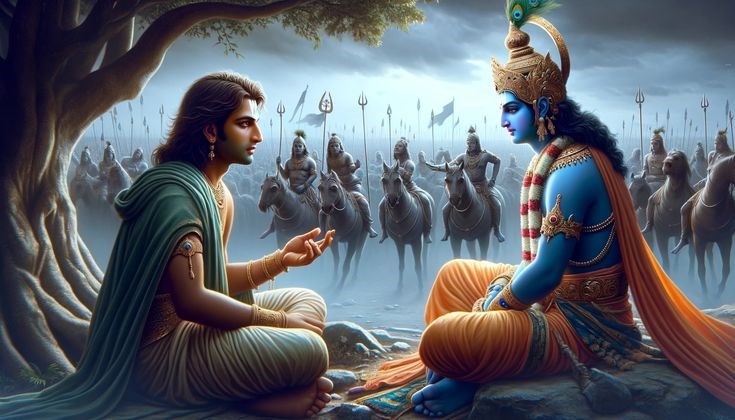
05-Jul-2025 , Updated on 9/9/2025 3:22:21 AM
Ashtavakra Gita vs. Bhagavad Gita
Distinct Origins and Audiences
Ashtavakra Gita and Bhagavad Gita are completely different in roots of origin and the target readership. The Bhagavad Gita is part of Mahabharata, the epic, which shows a conversation between Arjuna and Krishna. Its origin predisposes it to people who are involved in worldly business and experience ethical dilemmas because it promotes ways of doing things in society. On the other hand, the place of origin of the Ashtavakra Gita is not as much trimmed, as it has been associated with sage Ashtavakra and King Janaka traditionally. Its strict non-dual doctrine rejects rituals and action completely. This specific source point, then, demands as its immediate audience developed spiritual seekers who have already undertaken the radical path of renunciation in and of itself, rather than in the positive path of action as in the Bhagavad Gita.
Core Non-Dualism vs. Theistic Dualism
The Ashtavakra Gita and the Bhagavad Gita hold radically different metaphysical views. The Ashtavakra Gita is a treatise of fundamental non-dualism ( Advaita Vedanta), which holds that there is absolute singularity of Brahman. It states that the individual self (Atman) is the same as Brahman: everything that is perceived to be dual is illusion (Maya). It is only through the realization of this non-difference that liberation can come; ritual and devotion matter not. On the other hand, Bhagavad Gita promotes theistic dualism. It upholds an everlasting difference between individual souls (Jivas) and the supreme personal God (Ishvara, Krishna). Liberation entails such ways as devotion (Bhakti) and selfless activity (Karma Yoga) which are directed to communion with divinity but with due regard to the specific nature of the soul.
Detached Knowledge vs. Devoted Action
The Ashtavakra- Gita and Bhagavad Gita show differing ways of knowledge and action. The Ashtavakra Gita lays stress on detached knowledge (Jnana) as the only way of liberation. Recognition of the actual identity as the fixed Brahman destroys any idea of the doership and makes activity, even prescribed duty, unnecessary. Renunciation is itself a direct product of this non-dual insight. On the other hand, the Bhagavad Gita commends Nishkama Karma, containing selfless action with no attachment to the outcome. It requires a dutiful performance of social responsibilities (svadharma) in a committed way as disciplined activity with mental detachment is taken as the vital means of the spiritual process. The main difference lies in the way Ashtavakra denies the necessity of action by transcendent knowledge as contrasted with the means of combining dedicated action and detached wisdom as shown in Gita.
Absolute Self-Realization vs. Divine Relationship
The Ashtavakra Gita and Bhagavad Gita offer absolutely different ways to liberation. The Ashtavakra Gita preaches total self-realization, the individual self being the same person as the attributeless and supreme Brahman. Freedom can only come out of direct experience of this non-duality, which means a letting go of all identification, action, and the very notion of divine relationship, since the word relationship, means two. On the other hand, Bhagavad Gita focuses on the relationship with the God which is loving devotion to the personal god. In admitting non-dual truth, it enjoins self-sacrifice expressing itself in an action that is offered as service to the Divine. The liberation in this case is achieved by surrendering the individual personality to the Supreme Person.
Complementary Liberating Wisdoms
The Ashtavakra Gita and the Bhagavad Gita contain different but complementary ways of liberation (moksha). The Bhagavad Gita focuses on performing the duties of the world (karma yoga), devotional yoga (bhakti yoga) and disciplined yoga (jnana yoga) as a method to reach the eternal self and play your part. The Ashtavakra Gita, on the contrary, offers a way of direct, direct non-dual cognition (advaita). It teaches that the only way of being liberated is through the immediate recognition of the fact that the Self is free in nature, is Brahman, rejecting all actions, practices and even the very notion of bondage itself as an illusion. Collectively, they deal with opposite temperaments: one combines spirituality with the duties of life, and the other requires complete transcendence of all conceptual schemes. The two lead to a Self-realization.

Content Writer
Hi, I’m Meet Patel, a B.Com graduate and passionate content writer skilled in crafting engaging, impactful content for blogs, social media, and marketing.
Comments
Join Our Newsletter
Subscribe to our newsletter to receive emails about new views posts, releases and updates.
Copyright 2010 - 2025 MindStick Software Pvt. Ltd. All Rights Reserved Privacy Policy | Terms & Conditions | Cookie Policy